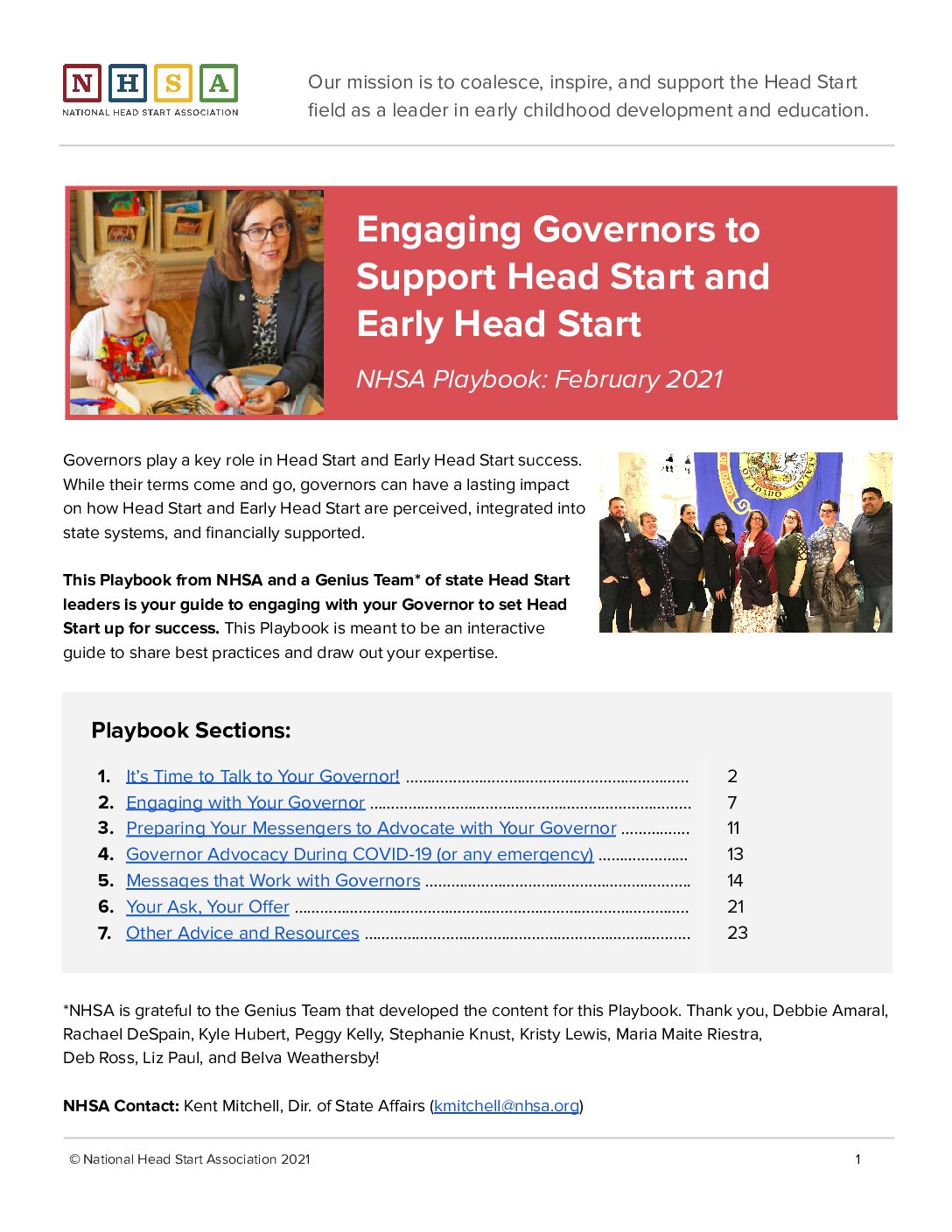 It wasn’t just a stroke of good luck when Governor Kate Brown of Oregon recently approved a state budget that includes $26 million for Early Head Start. It was the result of years of high-quality service delivery from Oregon Head Start and Early Head Start programs, awareness building, advocacy, and partnership work by the Oregon Head Start Association.
It wasn’t just a stroke of good luck when Governor Kate Brown of Oregon recently approved a state budget that includes $26 million for Early Head Start. It was the result of years of high-quality service delivery from Oregon Head Start and Early Head Start programs, awareness building, advocacy, and partnership work by the Oregon Head Start Association.
Although Head Start and Early Head Start are largely fueled by federal funding and regulations, governors are key to supporting program success or impeding progress. On a bipartisan basis, they have a growing interest in supporting early childhood education. In fact, in their 2021 State of the State Address, 18 governors focused on the importance of investing in the early years and supporting families with young children.
On the other hand, left uncultivated, their influence in Washington D.C. can open the door to systemic threats to Head Start and Early Head Start’s future, including shifting the program’s tried-and-true federal-to-local grant model to a less effective block-grant that would dilute the program’s connection to local communities, ability to adapt to what families need, and a strong focus on equity.
The good news? Over decades, the Head Start community has developed proven pathways to build support among governors and their staff, expand state partnerships and funding for Head Start and Early Head Start, and improve program quality and access. A team of state and local leaders joined NHSA to distill the experience of working with governors’ offices into a new NHSA Playbook: Engaging Governors to Support Head Start and Early Head Start. The Playbook focuses on three keys to success in working with governors:
- Know how governors are engaged in early childhood education;
- Find and use proven pathways to engage governors; and
- Use effective messages that resonate with governors.
Read on to strengthen your advocacy muscles in working with governors and their staff.
1) Know how governors are engaged in early childhood education.
It is important to know the many ways that governors are involved in early childhood education. Each presents an avenue for engagement and an opportunity to ask them to take action on Head Start’s behalf. Here are some of the most important ones:
- Governors develop state budgets that reflect their state’s priorities, including investments in education and public welfare. In fact, an estimated 21% of state budgets go to education and another 22% to public welfare programs. As a model multi-generational program, Head Start and Early Head Start support both the education and welfare of children and families.
- Governors oversee state agencies, the implementation of state laws, and many federal funding streams (including child care and home visiting dollars). They hire key staff, make key appointments, and develop working groups. How governors structure the workings of state government and the people they hire have a big impact on how well children and families are served. They particularly have broad powers with respect to education, though this can vary significantly by state.
- Critically for our field, governors host State Head Start Collaboration Offices funded by the Office of Head Start (and other sources) to help Head Start and Early Head Start programs succeed, including through integration into state and local systems. Collaboration directors can sit directly in a governor’s offices, but most sit in their state Department of Education.
- Governors often have to sign-off on major federal grant applications in order to submit them (e.g. Preschool Development Grants). Specific to Head Start, states can apply to be an Early Head Start-Child Care Partnership grantee.
2) Find and use proven pathways to engage governors.
- Get invited to stakeholder groups. Governors often have these groups to listen, learn, and build political and policy support. Even if the topic isn’t education or early childhood focused, look to join other groups based on the background of Head Start staff, allies, or others. It is most important to have a Head Start leader in the room.
- Lean into the expertise of your parent and family advocates. Remember that Head Start is strong and a leader in parent and family engagement and advocacy. Lawmakers often look to engage families and parents in policy initiatives. It is a strength you can leverage to open doors and positively influence policy.
- Share your expertise in poverty, trauma, and other issues. Head Start has expertise in addressing poverty and the realities for families living in it. Adverse Childhood Experiences (ACEs) and trauma is a focus that has been embraced on a bipartisan basis in many states, and Head Start is well versed in preventing and addressing childhood trauma.
- Connect your work to careers and jobs. Some governors may not have embraced early childhood education as a priority yet, but most, if not all, will have embraced some kind of career focus. Some will have a “Cradle to Career” vision, even if more of the emphasis is on K-12, higher education, and job training. Head Start creates jobs, supports parental aspirations, and prepares children for success in school and in life.
- Lean into their competitive spirit. Governors want to be #1 in many things. They look at high-profile rankings, such as those from the U.S. News and World report. They want to be first in education, community development, and workforce rankings. Embracing Head Start’s comprehensive, high-quality model can improve all of these areas for the state.
- Help them solve a crisis. A big part of executive governing is putting out fires. If you can help them address a crisis in child welfare, unemployment, or supporting communities experiencing violence, they will be more likely to listen.
3) Use effective messages that resonate with governors.
In speaking with a governor, you’ll want to tailor your message to your state and local context, current events, and their interests and background, but here is a 3-part message framework your peers suggest is effective as a starting point:
Head Start’s Impact
Head Start has positive results for our nation’s most at-risk children. Don’t be shy to share this good news with governors. A couple of key talking points:
- Head Start is run by local programs that serve children from birth to kindergarten, supporting their success in school and in life.
- Head Start supports our state’s most at-risk children with essential comprehensive education, health, and family support services, giving families an option many need as they struggle with living in poverty.
- Head Start intervenes early to stabilize families and prevent future costs to state governments, for example, by preventing placement in foster care.
- Head Start brings critical federal funding into the state and no state match is required.
- Head Start creates good jobs, strengthening family incomes, and supporting employment in distressed local economies.
Head Start’s Flexibility
No early childhood program is as flexible and able to respond to what families and communities need, and, as resilient as Head Start! A couple of key talking points:
- Head Start is the ONLY early childhood program that serves pregnant women and supports a child all the way through their transition to kindergarten.
- Head Start offers center-based and home-based options, while also partnering with local schools.
- Head Start is a critical infrastructure to help communities respond to and recover from emergencies, whether a pandemic, a flood, or a food crisis.
- Head Start is always working with states to improve collaboration and partnership.
Head Start’s Federal-to-Local Model
In some cases, you may need to directly discuss the benefits of Head Start’s unique federal-to-local model. If it arises or is a key message you need to carry to defend Head Start’s original design, here are some effective messages:
- The power of Head Start is it’s local design and the deep connections and roots grantees have in the communities they serve.
- Being locally-designed and through shared governance with parents, Head Start is able to ensure that programs meet unique family needs.
- By getting grants directly, Head Start programs maximize every federal dollar, making sure that all funding benefits children and families instead of getting trapped in bureaucracy.
We stand on the shoulders of giants, who have fought for Head Start and Early Head Start for many decades! By tapping into these decades of wisdom, we can build greater support among governors and increase the odds of Head Start’s success. Get engaged today through your State Head Start Association and Head Start State Collaboration Office to build more gubernatorial support for the life-changing program we all love!

